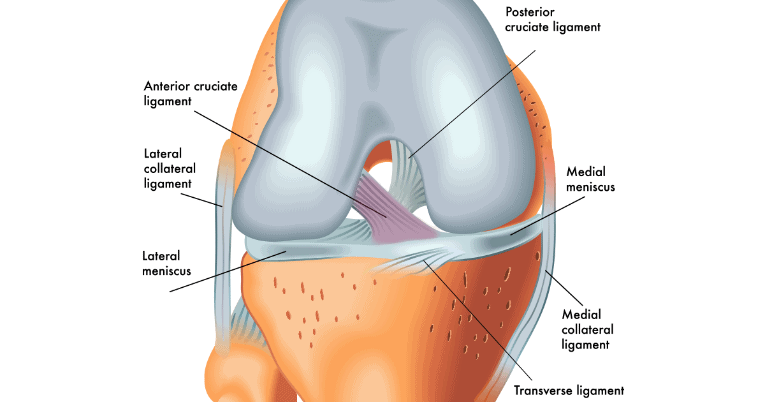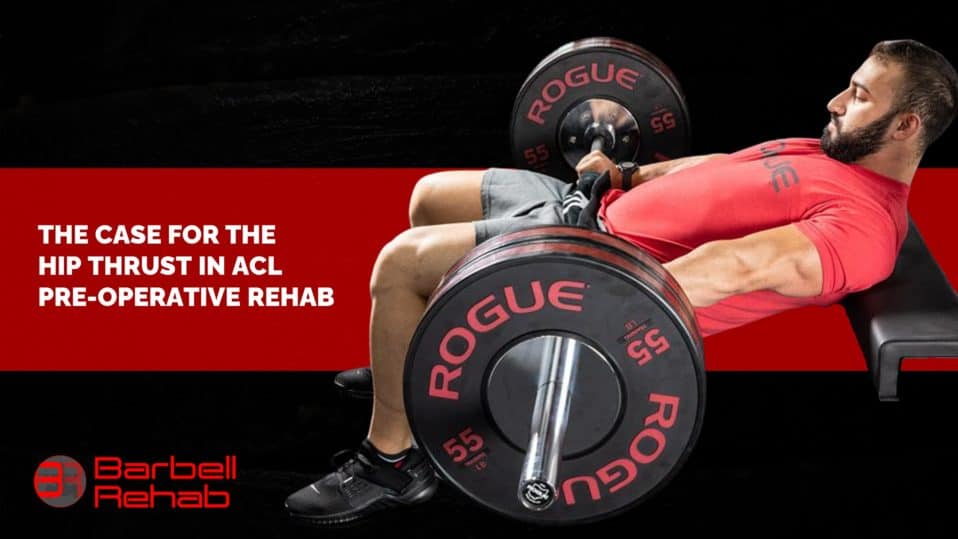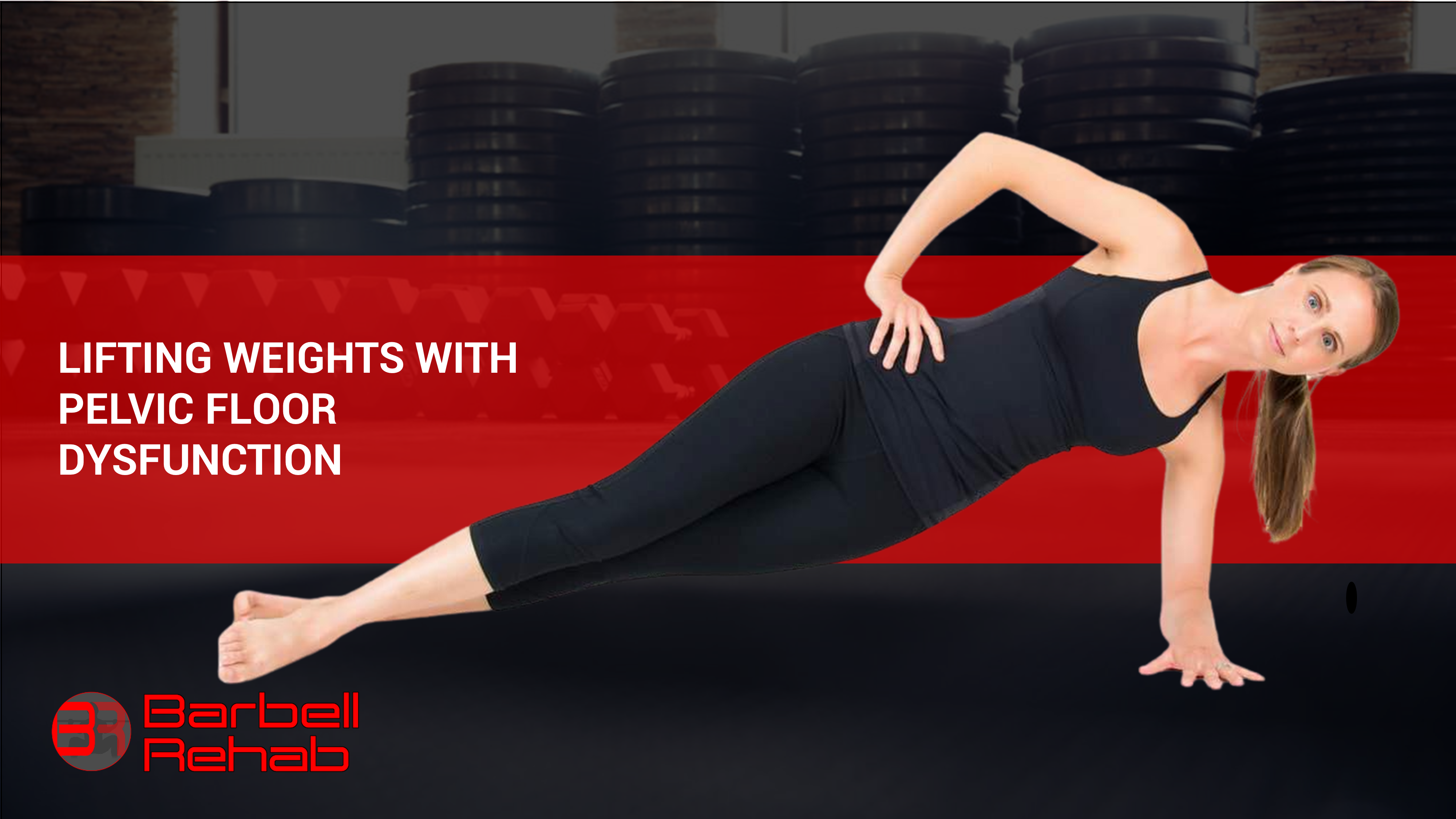Today's guest post is brought to you by Michelle Carroll, an online coach and personal trainer from Dublin, Ireland. She has a BSc in Radiography and is currently completing her MSc in Sports & Exercise Nutrition. Be sure to follow her on Instagram @michellecarroll1 to learn more.
The hip thrust is an exercise revered by Instagram influencers, athletes, and celebrities such as the Rock. Aside from seemingly being the key to glutes worthy of a Women’s Best sponsorship, what if the humble hip thrust offered the opportunity to build muscle and strength to aid athletes recovering from injury?
The article below will detail the issues with current ACL pre-operative rehabilitation, the potential benefits of including a hip thrust for ACL reconstruction rehab, and also address its limitations.
The Anterior Cruciate Ligament Injury
The anterior cruciate ligament (ACL) is a ligament that connects the femur to the tibia. It acts to give stability to the knee joint, by resisting forward movement of the tibia and rotational loading [1]. The ACL is commonly injured in field athletes, where there is sudden change in direction, velocity or impact.

Rupturing the ACL may render the knee unstable, and injuries can be managed operatively, or non-operatively.
No ACL tear is the same, and therefore the treatment requires consideration of the patients’ lifestyle, and whether they intend to return to sports or not. If the patient intends to return to high-level athletic activity, often a surgical reconstruction of the ACL is required [2].
The ACL reconstruction differs to traumatic bony injury (such as a fracture) in that often surgery doesn’t take place in the acute setting. Delayed diagnoses are common (typically up to 6 weeks) [3], with patients waiting up to 24 weeks from diagnosis to surgery.
The physiotherapist or orthopedic surgeon may advise patients carry out pre-operative rehabilitation before surgery, to prevent atrophy of the surrounding musculature and regain range of movement at the knee joint. Thus, the ACL injury is unique in that it gives patients the opportunity to “prepare” the body for surgery, which is not typically afforded to patients suffering other injuries.
Pre-Operative ACL Reconstruction Program
The benefits of pre-operative training in preparation for ACL reconstructive surgery are widely accepted in the literature. A systematic review of the literature carried out by Alshewaier et al. (2016) concluded that the outcomes of ACL reconstructions tend to be better in cases where a pre-operative exercise program was carried out. [4]
In the acute injury phase, the main aim is to stabilize the knee joint, and restore normal range of motion. As time progresses, and the patient is still awaiting surgical intervention, the focus moves toward muscular development.
Muscle aids in stabilizing the knee joint. Stronger musculature is associated with faster recovery times. Therefore, overall, pre-operative exercise programs aim to:
- Restore range-of-motion of the affected knee
- Increase muscular strength in the lower limbs and core
- Prepare the patient mentally for surgery [5]
The Main Components of Pre-Operative Programs
A deficit in quadricep muscle strength pre-operatively is associated with a poorer long-term surgical outcome [6]. Therefore, it stands to reason that building up the quadriceps is a huge focus.
Patients are taught exercises that focus on leg control, such as leg extensions and quad sets [7]. Restoration of functional range of movement is the focus, and weight/resistance training may or may not be directly prescribed.
The Role of Resistance Training
Unfortunately, comprehensive lower body resistance training isn't always prescribed for pre-operative ACL reconstruction, but restoring quadricep strength and size usually is.
So what is proven a thousand times over to result in muscle hypertrophy?...Resistance training [8]. In fact, studies have shown that the quadricep muscle architecture can change rapidly in response to resistance training after a mere ten weeks [9].
As stated above, knee instability is a key feature of the injured ACL. Resistance training as been proven to decrease knee laxity [10].
It is low impact, promotes muscular strength, and is associated with improved health markers. Furthermore, it also associated with a reduction in depression and anxiety, common features in the injured athlete [11].
Therefore, there is a good argument for the inclusion of resistance training as part of the pre-operative ACL reconstruction preparation.
Obviously, not all resistance training programs are created equal, and there is no one size fits all. Exercise selection, repetition ranges, and volume are just some of the key considerations when designing a program.
It is important that the rehab professional (physiotherapist) is consulted when designing this for the ACL reconstruction candidate, as the patient may have certain limitations on movement.
…Enter The Hip Thrust
With this in mind, and the decision to resistance train as part of surgical preparation opted for, exercise selection must be considered. Enter the king of Instagram lower body workouts, the hip thrust.
Panacea: The All-Encompassing Hip Thrust
In the interest of declaring my biases and conflicts of interest, I must confess that I am a hip thrust fanatic, and incorporated it into my own pre-operative exercise program. I am of the opinion that it accelerated my muscular strength and endurance, and had a favorable response in preparing me for surgery.
One girl's positive experience with an exercise does not make a program effective for all, and it’s possible it simply suited me and my biomechanics. However, I will outline some characteristics of the hip thrust that I believe merit it’s inclusion for pre-operative resistance training programs.
View this post on Instagram
Hip Thrust: Benefits for the Cruciately Challenged
Two reasons why I believe the hip thrust should be included in a pre-operative strengthening protocol:
- Addresses the biomechanical cause of injury.
- May reduce risk of reoccurrence of same.
The primary goal of the hip thrust is aimed at increasing strength and output of the hip extensor muscles. The muscles involved include the gluteal muscles, spinal stabilizer muscles, and the knee extensors (rectus femoris and vasti muscles, part of the quadriceps) [12].
Improvement in Hip Extensor Strength
You may recall from earlier in the article that the ACL is involved in absorbing impact from sudden deceleration, pivoting movement, and jumping. The hip extensor muscles are also involved in dealing with these forces.
By increasing the strength of the hip extensor muscles (the primary aim of the hip thrust), we may decrease reliance on the knee extensors (and by proxy, ligaments such as the ACL) to absorb impact [13].
A systematic review of the effects of the barbell hip thrust found that it offered the greatest the activation of the hip extensors when compared to more traditional exercises (e.g. deadlift). [14]
Certainly, if the athlete intends to return to a high sporting level, increasing both knee AND hip extensor strength can only be a positive adaptation.
Improvement in Knee and Hip Joint Stability
This is where the single-leg hip thrust shines. Lifting one leg whilst performing the hip thrust increases recruitment of the hip abductor and adductor muscle groups [15].
This may further aid stability of the hip (and subsequently knee) joint. Increasing the strength of stabilizing muscle groups has been linked with an increase in knee and hip joint balance. [16]
Easing Kinesiophobia
Kinesiophobia, or fear of movement (usually due to fear of pain or injury) is common amongst ACL reconstruction patients. It is one of the psychological factors that act as a barrier to 37% of patients returning to their pre-injury sporting level [17]. In fact, one study found that half the patients who didn’t return to sport reported fear of re-injury as an influencing factor. [18]
I would argue (and this is where science stops and anecdotal evidence steps in) that including the barbell hip thrust in your program can help ease kinesiophobia.
The barbell hip thrust can be loaded with some seriously heavy weight, and one can progress in load rapidly over time when compared to conventional lifts (deadlift, squat).
Given that you can seriously load the bar, and shift a serious amount of weight for decent reps with a ruptured ACL, imagine what you can do with a repaired one!
Transferrable Benefits into Post-Operative Rehabilitation
Post-operative rehabilitation is associated with restoring the athlete to pre-injury level. The focus is on developing the necessary skills for a safe return to sport, such as jumping, pivoting, bracing, balance and sprinting. [19]
Certain studies have found a positive association between the barbell hip-thrust and improved sprinting performance [20,14]. Systematic review also found the hip thrust to elicit better sprinting times and jumping capacity. Now this is not always the case, and some studies found it to offer no additional benefit to sprinting or power performance [21].
Regardless of the exact transferrable benefits, I would argue that anything that has the potential to ease post-operative rehabilitation should be included in a pre-operative training program.
The road to ACL recovery is long, and speaking from experience, if it can offer even the tiniest of benefit to me, I want in.
Caveats:
As this is not a scientific study, merely an opinion I have formed based on anecdotal experience and the literature at present, it should not be taken as gospel. Without conducting a study myself, it is impossible to say whether the hip thrust itself could provide any benefit directly to the ACL recovery.
Furthermore, it is difficult to ascertain whether any benefit produced would be due to the inclusion of resistance training alone or the exercise specifically.
I am a die-hard Instahun and by proxy I am predisposed to love a good hip thrust. I found it helped me build up strength in my legs and I believe this helped my recovery move along so efficiently. This is all my opinion however, and not provable scientific fact.
Regardless, I would argue that it is difficult not to advise someone conduct resistance training as part of their pre-operative preparation for ACL surgery, obviously assuming your condition and medical practitioner permit it. Every ACL tear is different, and if in doubt, consult your doctor or physio, not a random article on the internet.
I think further study on the benefits of pre-operative resistance training would be fascinating, and hopefully I will be able to participate in research examining it at some stage (obviously my MSc pending!).
References:
1. Duthon, V.B., Barea, C., Abrassart, S., Fasel, J.H., Fritchsy, D., Ménétrey, J. (2005) ‘Anatomy of the anterior cruciate ligament’, Arthroscopy.
2. Lam, M., Fong, D., Yung, P.S., Ho, E.P., Chan, W., Chan, K.M. (2009) ‘Knee stability assessment on anterior cruciate ligament injury: Clinical and biomedical approaches’, Sports Medicine & Arthroscopy Rehabilitation Therapy Technology.
3. Arastu, M.H., Twyman, R., Grange, S. (2015) ‘Prevalence and consequences of delayed diagnosis of anterior cruciate ligament ruptures’, Knee Surgery Sports Traumatology Arthroscopy.
4. Alshewaier, S., Yeowell, G., Fatoye, F. (2016) ‘The effectiveness of pre-operative exercise physiotherapy rehabilitation on the outcomes of treatment following anterior cruciate ligament injury: A systematic review’, Clinical Rehabilitation.
5. Millett, P.J. (2014) ‘ACL Reconstruction Rehabilitation Protocol’.
6. Eitzen, I., Holm, I., Risberg, M.A. (2009) ‘Preoperative quadriceps strength is a significant predictor of knee function two years after anterior cruciate ligament reconstruction’, British Journal of Sports Medicine.
7. Biggs, A., Jenkins, W.L., Urch, S.E., Shelbourne, K.D. (2009) ‘Rehabilitation for Patients Following ACL Reconstruction: A Knee Symmetry’, North American Journal of Sports Physical Therapy.
8. Abe, T., Kojima, K., Kearns, C.F., Yohena, H., Fukuda, J. (2003) ‘Whole body muscle hypertrophy from resistance training: distribution and total mass’, British Journal of Sports Medicine.
9. Blazevich, A.J., Cannavan, D., Coleman, D.R., Horne, S. (2007) ‘Influence of concentric and eccentric resistance training on architectural adaptation in human quadriceps muscles’, Journal of Applied Physiology.
10. Barcellona, M.G., Morrissey, M.C., Milligan, P., Clinton, M., Amis, A.A. (2015) ‘The effect of knee extensor open kinetic chain resistance training in the ACL-injured knee’, Knee Surgery, Sports Traumatology, Arthroscopy.
11. O’Connor, P.J., Herring, M.P., Caravalho, A. (2010) ‘Mental Health Benefits of Strength Training in Adults’, American Journal of Lifestyle Medicine.
12. Contreras, B., Cronin, J., Schoenfeld, B. (2011) ‘Barbell Hip Thrust’, Strength and Conditioning Journal.
13. Stearns, K.M., Keim, R.G., Powers, C.M. (2013) ‘Influence of Relative Hip and Knee Extensor Muscle Strength on Landing Biomechanics’, Medicine & Science in Sports & Exercise.
14. Neto, W.K., Vieira, T.L., Gama, E.F. (2019) ‘Barbell Hip Thrust: Muscular Activation and Performance: A Systematic Review’, Journal of Sports Science & Medicine.
15. Eckert, R.M., Snarr, R.L. (2014) ‘Barbell Hip Thrust’, Journal of Sport & Human Performance.
16. Hyrsomallis, C. (2009) ‘Hip adductors’ strength, flexibility and injury risk’, Journal of Strength and Conditioning Research.
17. Ardern, C.L., Webster, K.E., Taylor, N.F., Feller (2011) ‘Return to sport following anterior cruciate ligament reconstruction surgery: a systematic review and meta-analysis of the state of play’, British Journal of Sports Medicine.
18. Flanigan, D.C., Everhart, J.S., Pedroza, A., Smith, T.S., Kaeding, C.C. (2013) ‘Fear of Reinjury (Kinesiophobia) are Presistent Knee Symptoms Are Common Factors for Lack of Return to Sport After Anterior Cruciate Ligament Reconstruction’, Arthroscopy.
19. Van Grinsven, S., van Cingel, R.E., Holla, C.J., van Loon, C.J. (2010) ‘Evidence-based rehabilitation following anterior cruciate ligament reconstruction’, Knee Surgery, Sports Traumatology, Arthroscopy.
20. Williams, M.J., Gibson, N.V., Sorbie, G.G., Ugbolue, U.C., Brouner, J., Easton, C. (2018) ‘Activation of the gluteus maximus during performance of the back squat, split squat and barbell hip thrust and the relationship with maximal sprinting’, Journal of Strength and Conditioning Research.
21. Lin, K.H., Wu, C.M., Huang, Y.M., Cai, Z.Y. (2017) ‘Effects of Hip Thrust Training on the Strength and Power Performance in Collegiate Baseball Players’, Journal of Sports Science.





